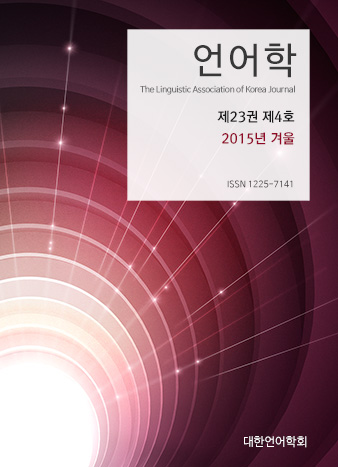대한언어학회 전자저널

Abstract
Jeon, Yoon-Shil. (2015). Vowel space differences in native and non-native focused words. The Linguistic Association of Korea Journal 23(4), 169-187. Vowel spaces of neutral and focused words in native English speech and those in non-native Korean learners' speech were compared to show the characteristics of acoustic realization of the vowel space expansion in focused words. In focused words produced by native English speakers, high front vowel /i/and back vowels /u, ʊ, ɑ/ show F2 shift. Specifically, /i/ is higher and /u, ʊ, ɑ/ are lower in F2 for focused words than for neutral words. High and mid-high vowels /i, ɪ, ʊ/ show higher F1. The results indicate that vowel spaces in focused words expand by fronting, retraction and lowering, not by raising of tongue body. In focused words of Korean learners of English, /æ, ɑ, ʊ/ have higher F1 and low front /æ/ shows lower F2. The vowel space expansion arose mainly due to retraction and lowering of tongue body. Relative to native English speakers, Korean learners of English generally realize higher F1 values of low vowels and lower F2 values of back vowels in both neutral and focused words, which means that back vowels show more backness and low vowels are much lower.
Keywords
# 모음 공간(vowel space) # 초점 단어(focused word) # 모음 공간 확장(vowel space expansion) # 제 1 포먼트(the first formant) # 제 2 포먼트(the second formant) # 한국인 영어 학습자(Korean le
References
- Coren, A. E., and Heckmann, C. L. (2004). Contrast enhancement of vowels in Modern Standard German, Journal of the Acoustical Society of America 114, 2363.
- Hay, J. F., Sato, M., Coren, A. E., and Diehl, R. L. (2003). A crosslanguage study of vowel sounds produced with and without emphasis: Testing the theory of adaptive dispersion, Journal of the Acoustical Society of America 111, 2367.
- Kendall, T., & Fridland, V. (2012). Variation in perception and production of mid front vowels in the U.S. Southern Vowel Shif, Journal of Phonetics 40, 289-306.
- Klatt, D. H. (1976). Linguistic uses of segmental duration in English: Acoustic and perceptual evidence, Journal of Phonetics 3, 129-140.
- Kuhl, P. K., Andruski, J. E., Christivich, I. A., Christovich, L. A., Kozhevnikova, E. V., Ryskina, V. L., Stolyarova, E. I., Sundberg, U., & Lacerda, F. (1997). Cross-Language Anaylsis of Phonetic Units in Language Addressed to Infants, Science 227, 684-686.
- Lindblom, B. (1986). Phonetic universals in vowel systems, in Experimental Phonology, edited by J. Ohala and J. Jaeger (Academic, New York), pp. 13-44.
- Newman, R. (2003). Using links between speech perception and speech production to evaluate different acoustic metrics: A preliminary report, Journal of the Acoustical Society of America 113, 2850-2860.
- Rump, H. H., & Collier, R. (1996). Focus conditions and the prominence of pitch-accented syllables, Language and Speech 39, 1-17.
- Smiljanic, R., & Bradlow, A. R. (2005). Production and perception of clear speech in Croatian and English, Journal of the Acoustical Society of America 118(3), 1677-1688.
- Umeda, N. (1975). Vowel Duration in American English, Journal of the Acoustical Society of America 58, 434-445.
- Yang, B. (1996). A comparative study of American English and Korean vowels produced by male and female speakers, Journal of Phonetics 24, 245-261.